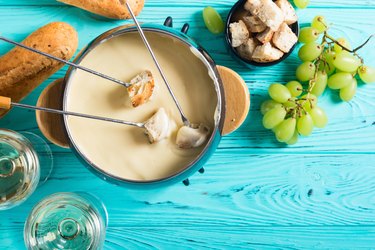
Fondue is the ultimate in celebratory dining. Melted cheese in a pot that you dip things in alongside your best buds?! It's a no-brainer! And a truly communal experience—we can think of nothing more fun than throwing a party centered around delicious dips.
But how do you have a great fondue experience at home? Whether you're a beginner or pro, it's really a matter of having the appropriate pot, tools, dip selection and pairings. With this in mind, we've put together a thorough guide to preparing the perfect fondue, including information about the best fondue wine pairings, accompaniments and more. You'll be entertaining (and satisfying your cheesiest cravings) in no time!
Video of the Day
Video of the Day
Part 1: Fondue Fundamentals
The fundamentals of fondue are straightforward. You'll need foods to dip, forks to dip them with and a dipping pot full of something hot. There are three main kinds of fondue:
1. Classic cheese fondue
2. "Hot pot" fondue (where the pot is filled with broth or hot oil)
3. Dessert fondue, especially with chocolate sauce
We'll focus primarily on cheese fondue, but the other types of fondue will also make an appearance in our guide.

The two main ingredients in cheese fondue are cheese (of course) and dry white wine. Wine helps dissolve cheese, while its acidity breaks down proteins to give your fondue a smooth texture. It also cuts the richness of the cheese, which your belly will undoubtedly appreciate.
Fondue recipes might also call for a whiff of garlic or nutmeg, a starch, lemon juice or even a splash of kirsch—a cherry brandy from Europe. Kirsch isn't the sticky-sweet stuff you'll find at a college party but high-quality brandy with subtle flavor.
Part 2: Fondue Pots
Broadly speaking, there are two types of fondue pots. One is made from thin, lightweight metal, while the other is thicker and can be all-metal, made from enameled cast iron or some kind of ceramic. Thin, lightweight pots are best suited for broth or oil fondue. You can use them for cheese, but you'll need to stir frequently to prevent hot spots.
Thicker pots take longer to warm up but provide steady, even heat that's preferable for cheese and especially useful for chocolate. There are even electric models if you don't want to fuss with candles or burners. You can pull off a successful cheese fondue in any pot—it's merely a question of adapting to the pot's nature.
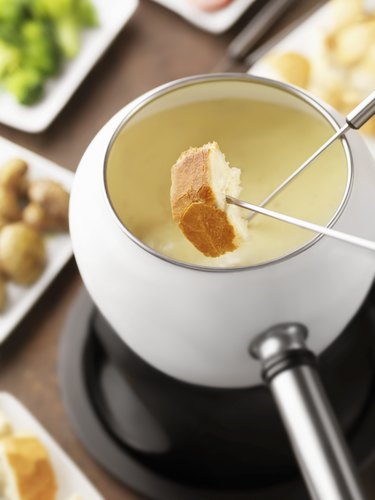
Vintage fondue pots can sometimes be sourced from local thrift stores, though there's been a revival of interest and they're not as plentiful as they used to be. If you're buying something new, you should find an option to suit your style (and budget!) in our recent roundup of the best fondue pots.
Part 3: Preparing Basic Cheese Fondue
Now that you're ready to take the plunge and organize a fondue party, it's time to consider practical details. We'll focus on beginner-friendly fondue tips that will help you get you it right the first time.
1. Don't go overboard on wine
Fondue requires a passable white wine that's dry and reasonably acidic. That's all! So don't sweat picking out something special to pour into your pot: If anything, an upgraded wine is likelier to have flavor notes that will clash with cheeses. Put your money toward better cheese and save that nicer bottle to drink as a fondue wine pairing. Sauvignon blanc, Pinot Gris/Pinot Grigio and unoaked Chardonnays are all acceptable. Boxed white table wine will usually even do the trick.
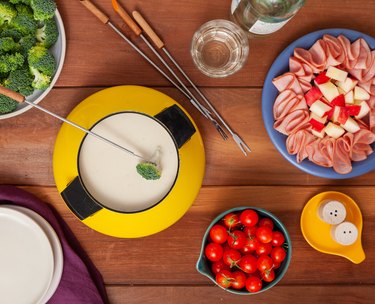
If the wine you choose isn't especially acidic, complement it with a splash of lemon juice. Cream of tartar will also work, as will powdered citric acid products used to keep fruit from turning brown, but you're more likely to have lemon juice on hand.
Tip
A good rule of thumb is to allow one cup of wine per pound of cheese, so a standard bottle of wine will do for up to three pounds of cheese.
2. Select the right cheeses
The most iconic cheese pairing for fondue is Emmentaler (the old-country version of what you might know as Swiss) and Gruyère cheese in equal quantities. Emmentaler is mild and melty, while Gruyère adds a bigger punch of bold flavor. You can add as many other cheeses as you like, provided they melt smoothly and don't get stringy (so skip the mozzarella!). In Switzerland, a mild cheese called vacherin is a popular third option for fondue, but Fontina works when you can't track vacherin down. Other alpine cheeses like Comté and Appenzeller are also reliable choices.
Feel free to experiment, though: Any cheese is worth a try if it matches the mild and buttery niche of Swiss or Gruyère's pungent nuttiness. When in doubt, melt a bit of the cheese in your microwave or toaster oven and see if it's smooth and oozy. If so, it'll probably work.
Good Cheeses for Fondue
When it comes to cheese for fondue, these cheeses are safe bets:
- Emmentaler or Swiss
- Gruyère
- Vacherin
- Fontina
- Comté
- Appenzeller
3. Shred the cheese
Cheese that's cut into small blocks or thin slices will melt, but it won't melt as quickly or evenly as shredded cheese. Shredded cheese also provides an opportunity to stack the deck in your favor by tossing shreds with a bit of cornstarch. The starch does two things: It helps keep the cheese from clumping, and it stabilizes the fondue to prevent "splitting" or "breaking" (i.e., separating into liquid and grainy bits of cheese protein). Purists don't use starch, but it's a great safety net for beginners.
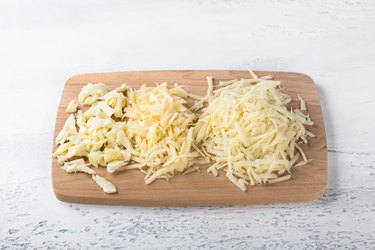
4. Don’t rush the melting process
We all know the saying "Patience is a virtue." It really applies here, because creating fondue properly requires plenty of patience. Start by warming wine over medium heat until it's just on the verge of a boil. Turn down to a low heat and begin adding grated cheese by sprinkling a handful atop the wine. Stir until it's all dissolved, then sprinkle in another handful. Don't just drop in a big mound of shreds—this is likely to cause clumping. (It's even more of a risk with slices and cubes, which is why grated or shredded cheese is your friend.) Work at a slow and steady pace, and use the lowest temperature your stove can manage. If necessary, move the pot on and off the burner. Repeat this process until all cheese is incorporated, then you can move your pot to the heating stand and get the party started.
It's usually best to heat your cheese mixture on the stovetop before moving it to the fondue burner. This provides more control over the heating process, which means there's less chance of messing up your fondue. It's also faster and more convenient. Electric pots are the only exception, as they have enough oomph to heat and prepare cheese in one continuous step.
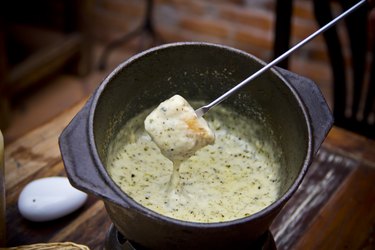
The cook time listed in most recipes is usually a bit optimistic, so the total time to prepare fondue will probably be longer than you anticipate (especially for a big batch). Stick with it and resist the temptation to crank up the heat. That's a mistake, and let's face it: Having to start over will take a lot longer.
5. Add supplementary flavors
The most classic addition to fondue cheese is a whiff of garlic, usually achieved by rubbing a split garlic clove around the inside of the pot before adding wine and cheese. Some recipes call for a pinch of nutmeg, which lends a subtle "something" that's hard to identify. (If you can tell it's nutmeg, you've used too much.) Kirsch or some other form of brandy is entirely appropriate—and if you don't sweat authenticity, you can even add things like flavored liqueur or fresh herbs. You do you!
6. Select creative "dippers"
Historically, stale bread cubes were used for fondue. Let's face it—that's nobody's idea of fun. Toasted fresh bread is the contemporary equivalent, and it's a fantastic starting point. You can use untoasted fresh bread too, but it needs to be something that will stay on the fork when dipped: crusty like a French baguette or dense like a rustic rye or whole-grain loaf. Cooked potatoes are another option you'll often see in Switzerland. They're usually fingerlings or another form of "waxy" potato (i.e., not a russet).
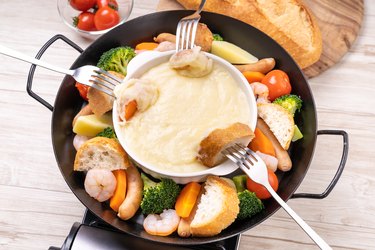
Beyond those defaults, there are lots of other dippers to consider. Wedges or chunks of cheese-friendly fruits such as pears and apples are great options, as are crunchy vegetables like broccoli, cauliflower, sweet peppers or even celery. For something heartier, consider meatballs or pieces of sliced, cooked sausage and ham. Pickles, marinated veggies or mushrooms work just as well.
Bottom line: If it goes with cheese and will stay on the fork, it's worth a try. Even large, firm pieces of cooked pasta will work, though they're certainly not traditional.
Great Dippers for Fondue
You can't go wrong with these "dippers" to dip in cheese fondue:
- Toasted fresh bread
- Fingerling potatoes
- Pears
- Apples
- Broccoli
- Cauliflower
- Sweet peppers
- Celery
- Meatballs
- Cooked sausage
- Ham
- Pickles
- Marinated veggies
- Mushrooms
- Cooked pasta
- Pretzels
- Breadsticks
- Tortilla chips
7. Consider skipping the fork
Forgo the fork by using pretzels or breadsticks—as long as your guests can be trusted not to double-dip. In fact, you might want to skip this idea with the kids. For another twist, set out ladles and serve small plates of food to drizzle with cheese. Think: tortilla chips, cooked vegetables and more.
Tip
Did you know that fondue is fantastic as a leftover? At the end of the night, refrigerate any remaining fondue in an airtight container. You can reheat it later to use as a cheese sauce over pasta and cooked vegetables or spread it on bread before broiling in your toaster oven. It makes a great snack or light meal.
When the fondue is all eaten up or sent to the fridge as leftovers, you will usually find a layer of cheese stuck to the bottom of the pot. This is glorious stuff, so peel it off and divide it up between your guests as a final treat (or save it for yourself as a reward for cleaning up).
Part 4: Fondue Pairings
1. Appetizers are A-OK
That pot of melted cheese will inevitably be the centerpiece of your get-together, but don't neglect the rest of your spread. For a full-scale fondue party, plan on a few (light) appetizers beforehand. When you serve fondue, set out small, fresh accompaniments that will counter its richness. Think: vegetable trays or pickles and marinated veggies.
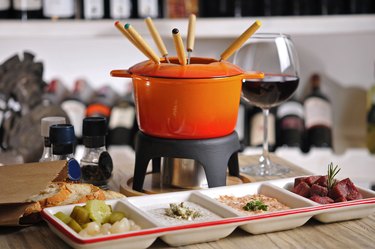
2. Select the perfect fondue wine pairing or other sip
A classic fondue wine pairing is dry white wine, though warm herbal teas are also a great choice. Both of which—according to Swiss tradition—help our bodies process all that rich food. Beer and other cold beverages are traditionally shunned, as they're thought to make cheese congeal and become harder to digest. These are just suggestions, though: Feel free to down a brew with your fondue if that's what you like. A dry sparkling wine (Spanish cavas are usually great bargains) might be the very best beverage option of all, and it's impeccably festive.
Part 5: Broth or Oil Fondue
While classic fondue is made from cheese, broth or oil fondue can be just as tasty. With these, you'll skewer pieces of meat, poultry, seafood, vegetables or mushrooms on fondue forks and cook them in the hot oil or broth. Dippers can be eaten directly from the fork or transferred to flatbread or a bed of rice. If you start with a pot full of broth, it will become richer with every piece of food that's dipped. At the end of the meal, consider dividing broth between guests in small cups for everyone to enjoy.
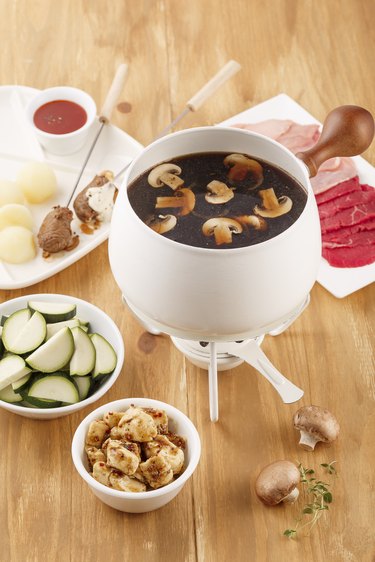
Oil fondue is similar, but each piece is individually deep-fried. Vegetables and some proteins, such as shrimp, can be dipped directly into the oil. For others, you'll want to have a bowl of batter handy (tempura batter is a good choice) so guests can dip each piece in batter first and then into the fat.
Your choice of accompaniments will vary depending on flavor profile. This kind of "hot pot" approach to group cookery is common in parts of Asia, for example, so you might lean toward beer as an accompaniment. If the foods will mostly be battered and fried, you might stick with dry wine to cut the richness of the fat (as with cheese fondue).
Warning
Hot oil fondue has a higher risk of injury than other forms of fondue. If you’re working over an alcohol burner or similar heat source, there’s a risk of oil bubbling over and igniting. With electric fondue pots, there’s the potential for a guest to trip over the cord and spill hot oil, potentially causing serious burns. Be sure not to overfill the pot (it’ll bubble up as you put foods into the oil), and arrange your furniture and seating so food traffic doesn’t cross the spot where your pot’s electrical cord runs to the wall outlet. It’s also prudent to keep alcohol to a minimum when you’re working with hot oil.
Part 6: Chocolate Fondue
For chocolate fondue, you'll typically use a smaller pot (a little goes a long way) and work with lower temperatures because chocolate scorches easily. Most fondue sets made specifically for chocolate use tea light candles for heat, though some electric fondue pots offer low enough temperature settings for chocolate.
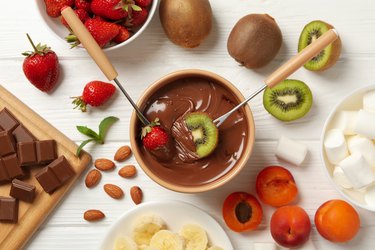
Fill the pot entirely with chocolate if you wish or thin chocolate slightly with heavy cream or a splash of vegetable oil to give it a more "dip-friendly" consistency. Oil is added for chocolate fountains, which are just splashier versions of chocolate fondue. Your dippers can be shortbread fingers or other cookies, cubes of dense pound cake, fresh fruit and berries, marshmallows, pieces of dried fruit, cake pops on their sticks or even small scoops of hard-frozen ice cream. The possibilities are endless—and delicious.
Chocolate fondue's sweetness determines what you'll serve with it. Milk chocolate is a tough match for wine because of its sweet flavor, though dessert wines and off-dry wines (like a sweeter Riesling) hold up nicely. Dark chocolate is less assertively sweet, so full-bodied red wines like Zinfandel and Cabernet Sauvignon make an interesting choice. Nonalcoholic choices include strong coffee or herbal tea, especially those with berry flavors to bring out subtle fruity notes in the chocolate itself.
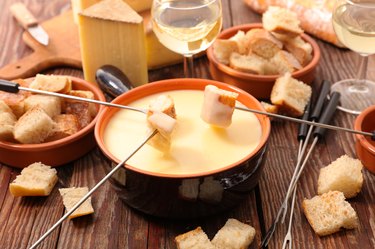
So there you have it: Everything you need to throw the fondue party of your dreams. As you gather with loved ones for a delectable dining adventure, you'll fall in love with the endless creative possibilities afforded by fondue.
Grab those dippers and dig in!